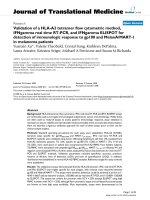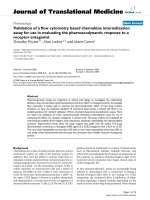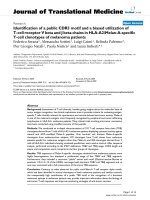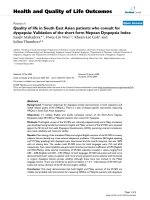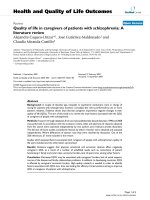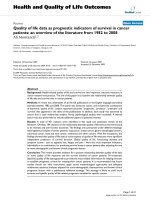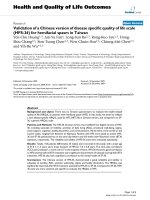báo cáo hóa học: "Quality of life in Brazilian obese adolescents: effects of a long-term multidisciplinary lifestyle therapy" pdf
Bạn đang xem bản rút gọn của tài liệu. Xem và tải ngay bản đầy đủ của tài liệu tại đây (249.91 KB, 8 trang )
BioMed Central
Page 1 of 8
(page number not for citation purposes)
Health and Quality of Life Outcomes
Open Access
Research
Quality of life in Brazilian obese adolescents: effects of a long-term
multidisciplinary lifestyle therapy
Mara Cristina Lofrano-Prado*
1
, Hanna Karen Moreira Antunes
2
, Wagner Luiz
do Prado
3
, Aline de Piano
1
, Danielle Arisa Caranti
1
, Lian Tock
1
,
June Carnier
1
, Sergio Tufik
4
, Marco Túlio de Mello
1,4
and Ana R Dâmaso
1,2
Address:
1
Post-Graduate Program in Nutrition, Federal University of São Paulo/Paulista School of Medicine, Marselhesa Street, 535, São Paulo/SP,
Brazil,
2
Department of Health Sciences, Federal University of São Paulo, Baixada Santista Campus, Santos/SP, Brazil,
3
Department of Physical
Education, Pernambuco University, Arnóbio Marques Street, 310, Recife/PE, Brazil and
4
Department of Psychobiology, Federal University of São
Paulo/Paulista School of Medicine – Marselhesa Street, 500, São Paulo/SP, Brazil
Email: Mara Cristina Lofrano-Prado* - ; Hanna Karen Moreira Antunes - ; Wagner Luiz
do Prado - ; Aline de Piano - ; Danielle Arisa Caranti - ;
Lian Tock - ; June Carnier - ; Sergio Tufik - ; Marco Túlio de
Mello - ; Ana R Dâmaso -
* Corresponding author
Abstract
Background: Obesity has adverse physical, social, and economic consequences that can negatively
affect quality of life (QOL). Thus the aim of this study was to verify the effects of a long-term
multidisciplinary lifestyle intervention on QOL, body image, anxiety, depression and binge eating in
obese adolescents.
Methods: Sixty-six obese adolescents (41 girls and 25 boys; BMI: 35.62 ± 4.18 kg/m
2
) were
recruited from the Multidisciplinary Obesity Intervention Program outpatient clinic, and were
submitted to a multidisciplinary lifestyle therapy (short-term = 12 weeks and long-term = 24
weeks), composed of medical, dietary, exercise and psychological programs. Validated self-report
questionnaires were used to assess symptoms of anxiety Trait/State (STAI); depression (BDI); binge
eating (BES), body image dissatisfaction (BSQ) and QOL (SF-36). Data were analyzed by means of
scores; comparisons were made by ANOVA for repeated measures, and Tukey's test as post-hoc
and Students T test.
Results: Long-term therapy decreased depression and binge eating symptoms, body image
dissatisfaction, and improved QOL in girls, whereas, for boys, 24 weeks, were effective to reduce
anxiety trait/state and symptoms of binge eating, and to improve means of dimensions of QOL (p
< .05).
Conclusion: A long-term multidisciplinary lifestyle therapy is effective to control psychological
aspects and to improve QOL in obese adolescents.
Published: 3 July 2009
Health and Quality of Life Outcomes 2009, 7:61 doi:10.1186/1477-7525-7-61
Received: 23 March 2009
Accepted: 3 July 2009
This article is available from: />© 2009 Lofrano-Prado et al; licensee BioMed Central Ltd.
This is an Open Access article distributed under the terms of the Creative Commons Attribution License ( />),
which permits unrestricted use, distribution, and reproduction in any medium, provided the original work is properly cited.
Health and Quality of Life Outcomes 2009, 7:61 />Page 2 of 8
(page number not for citation purposes)
Background
Obesity has become an important public health problem
worldwide, affecting different population groups on a
pandemic scale [1,2]. Obesity is a chronic multifactor dis-
ease, that leads to multiple medical complications and
psychological disorders [3,4]. In Brazil, recent data have
shown that the prevalence of overweight and obesity in
adolescent boys and girls was 16.1% and 17.5%, respec-
tively [5].
Obesity is associated with physical problems, such as
hypertension, coronary arteriosclerosis, elevated choles-
terol, type 2 diabetes, joint problems, stroke, and certain
types of cancers [6]. Psychologically, it is associated with
several problems, such as lower self-concept, negative self-
evaluation, decreased self-image, anxiety and depression
[7], which are related to somatic and psychological symp-
toms (e.g. being teased, hit, or bullied, and presenting
high-risk behavior) [8,9].
In addition, obesity has also adverse physical, social, and
economic consequences that can negatively affect quality
of life (QOL). As a result, QOL has become an important
endpoint assessed in obesity and weight loss intervention
studies [10].
However, few studies have examined the effects of lifestyle
modification programs on changes in QOL among over-
weight and obese individuals. These studies suggest that
physical activity combined with diet can be effective in
improving health related QOL in several domains, includ-
ing social functioning, mood, and self-esteem [11,12]. In
general, obesity seems to have a greater impact on physi-
cal rather than mental functioning [13].
Therefore, current studies have shown that short-term
weight loss has a positive effect on QOL in adults [7]. Nev-
ertheless the effects of long-term therapies in adolescents
have not been investigated. Thus the aim of this study was
to verify the effects of a long-term multidisciplinary life-
style intervention on QOL, body image, anxiety, depres-
sion and binge eating in obese adolescents.
Methods
Population
Obese adolescents were recruited from the Multidiscipli-
nary Obesity Intervention Program outpatient clinic of
the Federal University of São Paulo, in São Paulo, an
urban city in Brazil. Sixty-six obese adolescents (41 girls
and 25 boys; BMI: 35.62 ± 4.18 kg/m
2
) aged from 13–19
years old were included in the study. The inclusion criteria
were: Tanner pubertal stage 3 or 4 (post pubertal) [14],
primary obesity (BMI >95th percentile of the Centers for
Disease Control reference charts) [15], and agreement of
the adolescents and their families to participate, in a long-
term multidisciplinary lifestyle therapy (24 weeks). The
exclusion criteria were: identified genetic, metabolic or
endocrine disease, chronic alcohol consumption, previ-
ous drugs use, and less than 75% compliance in all exer-
cise, nutritional, psychological, and clinical sessions.
Telephone surveys were conducted to investigate the rea-
sons for dropping out of the program.
This study was carried out in accordance with the princi-
ples of the Declaration of Helsinki and was formally
approved by the Ethics Committee of the Federal Univer-
sity of São Paulo – Paulista School of Medicine (#0135/
04). Informed consent was obtained from all subjects
and/or their parents.
Study Protocol
On the first visit, subjects were medically screened, had
their pubertal stage assessed, and their anthropometrics
profile measured (height, weight, BMI, and body compo-
sition) (Figure 1). For each subject, the procedures were
performed at the same time of day and at least 15 hours
after the last training session in order to avoid diurnal var-
iations. Thereafter, obese adolescents started the multidis-
ciplinary lifestyle therapy (short-term = 12 weeks and
long-term = 24 weeks), composed of medical, dietary,
exercise and psychological programs, as described bellow.
Clinical Therapy
To accomplish healthy clinical parameters, the patients
visited the endocrinologist once a month. Medical follow-
up included initial medical history, physical examination,
and appropriate tests followed by regular clinical surveil-
lance.
Psychotherapy
The adolescents participated in weekly psychological
group sessions to discuss body image and eating disorders
(bulimia and anorexia nervosa, binge eating, their signals,
symptoms and their consequences for health), the rela-
tion between food and feelings, family problems among
others. Individual psychological therapy was performed
when nutritional or behavioral problems were identified.
Nutritional Therapy
Nutritional lessons on food pyramid, recorded inquiry,
weight loss diets, diet vs. light, fat and cholesterol, and
nutrition facts were held once a week. No fixed caloric
intake was prescribed; the subjects were only encouraged
to reduce their food intake and follow a balanced diet.
Physical Therapy
The adolescents underwent a personalized, moderate aer-
obic training program (60 min/session), three times a
week (180 min/week), under the supervision of a sports
physiologist. Each program was developed according to
Health and Quality of Life Outcomes 2009, 7:61 />Page 3 of 8
(page number not for citation purposes)
the results of an initial oxygen uptake test for aerobic exer-
cises (cycle ergometer and treadmill). The exercise pro-
gram was based on that of the American College of Sports
Medicine [16]. Information about lifestyle changes
related to activity was also provided and spontaneous
physical activity (walking, stair climbing, etc.) was
encouraged, but not measured.
Anthropometric measurements and Body Composition
Subjects were weighed on a Filizola scale to the nearest 0.1
Kg wearing light clothing and no shoes. Height was meas-
ured to the nearest 0.5 cm by means of a wall-mounted
stadiometer (Sanny, model ES 2030). BMI was calculated
as body weight (kg) divided by height (m) squared (kg/
m
2
). Body composition was estimated by Plethismogra-
phy in the BOD POD
®
body composition system (version
1.69, Life Measurement Instruments, Concord, CA) [17].
Questionnaires
The following questionnaires were applied at baseline,
after the short and long-term therapy:
1) STAI – Spielberger State-Trait Anxiety Inventory – a self-
rated questionnaire divided in two parts: anxiety-trait
(referring to personality traits) and anxiety-state (referring
to systemic aspects of the context), translated into Portu-
guese and validated for the Brazilian population. Each
part has 20 statements. Responses are in a 1–4 scale. Anx-
iety-state refers to how individuals feel 'at the moment',
and anxiety-trait to how they 'generally feel'. Each part
varies from 20 to 80 points, and the scores indicate low
(0–30), medium (31–49) or high (50 or more) anxiety
levels [18].
2) SF-36 – Health Research – Generic Questionnaire for
Evaluation of Quality of Life 'Medical Outcomes Study SF-
36' – Translated into Portuguese and validated for the Bra-
zilian population. This is a multidimensional instrument
consisting of 36 items to generically evaluate the QOL
scored on 8 multi-item scales: physical functioning, role-
physical, pain, general health perception, vitality, social
functioning, role-emotional, mental health, plus a one-
item measure of self-evaluated change in health status in
the past year [19].
3) BSQ- Body Shape Questionnaire – Translated into Por-
tuguese and validated for the Brazilian population. A 34-
item measure of body dissatisfaction assesses the fre-
quency of concern and distress about body size/shape.
The subjects rate items on a scale from 1 (never) to 6
(always); higher scores reflect greater body dissatisfaction.
The subjects were classified into light (between 81 and
110 points), moderate (between 111 and 140), and severe
(more than 140 points) body image dissatisfaction [20].
4) BES- Binge Eating Scale – Translated into Portuguese
and validated for the Brazilian population [21]. BES is a
16-item self-reported questionnaire, designed specifically
to identify behavioral and cognitive characteristics of
binge eating in obese individuals. Each item presents
three or four differently weighted statements, with a final
score varying from 0–46. It is used to identify binge eaters,
Study protocol diagramFigure 1
Study protocol diagram.
Media 13 a 19
y
earsBMI 30 K
g
/
m
2
Pubertal Evaluation
ECG Blood Collect
Body Composition
Exercise
3x week -
1 hour
Nutritional
Intervention
Once a week
Psychological
Intervention
Once a week
Clinical
Evaluation
Once a month
Clinical Evaluation
Ethical
Commit
tee
0135/04
Health and Quality of Life Outcomes 2009, 7:61 />Page 4 of 8
(page number not for citation purposes)
to evaluate binge eating severity and also as a parameter
for treatment outcome. Based on BES scores, disturbed
eating behavior is classified into three different levels of
severity: non-bingers (scoring 17 and less), moderate bin-
gers (scoring between 18 and 26), and severe bingers eat-
ers (scoring 27 and above) [22].
5) BDI – Beck Depression Inventory. The Brazilian version
was used [23]. There are 21 clinical symptoms of depres-
sion, while the remaining 10 items cover affective, behav-
ioral, somatic, and interpersonal aspects of depression.
Each item consists of a series of four statements scaled to
indicate increasing depressive symptomatology. Scores 5–
9 indicate that these ups and downs are considered nor-
mal; 10–18, mild to moderate depression; 19–29, moder-
ate to severe depression, and 30–63, severe depression.
The scale was applied on the first day of the evaluation
and after the training period [24].
The questionnaires were applied in a quiet room. Before
beginning, the procedures were explained and the volun-
teers were asked to respond honestly.
Statistical analysis
All data were analyzed by means of STATISTICA
®
version
6 for Windows
®
, with significance set at p £ 0.05 and
expressed as means ± SD.
Baseline, short and long-term multidisciplinary treat-
ments were compared using analysis of variance
(ANOVA) for repeated measures, and Tukey's post-hoc
test was performed when necessary. Independent t-tests
were used for comparison between genders. For compari-
sons between pre and post-treatment, effect size was
expressed as a correlation and was displayed when it was
up to moderate (>0.3) as proposed by Cohen [25].
Results
In the present study, 63% (girls) and 77% (boys) com-
pleted 24 weeks of a multidisciplinary lifestyle therapy
with more than 75% compliance in all exercise, nutri-
tional, psychological, and clinical sessions. For both gen-
ders, the drop out rate before 12 weeks was 12%.
As expected, boys were heavier, taller and had more fat-
free mass than girls in all evaluations. After the short-term
multidisciplinary lifestyle therapy, both genders showed
significant reductions in body mass, BMI and fat mass,
without differences for 24 weeks, except a decrease in fat
mass after the long-term therapy in girls. No changes in
fat-free mass were observed after the treatment, and ado-
lescents remained obese even with BMI reduction (32.04
± 5.20 and 32.59 ± 4.50, for boys and girls respectively)
(table 1).
No genders differences were observed at baseline for
symptoms of depression, anxiety state, binge eating and
neither on lifestyle dimensions. However, girls had higher
scores of anxiety trait and body image dissatisfaction
before the therapy and after the long-term therapy, while
boys had higher scores of physical function and pain (p <
.05). No therapy effects were found after the short-term
therapy in girls. On the other hand, after 24 weeks there
were a decrease in depression symptoms (effect size =
.36), body image dissatisfaction, binge eating symptoms
(effect size = .38) and improvement on general healthy
perception dimension of QOL. For boys, the short-term
therapy improved body image dissatisfaction, and dimen-
sions of QOL, such as physical function, role physical and
role emotional (p < .05). Likewise, the long term-treat-
ment was effective to reduce anxiety traits (effect size =
.31) and state scores, and symptoms of binge eating,
related to QOL. Twenty-four weeks of therapy improved
vitality, role emotional and mean of dimensions. Moreo-
ver, the long-term therapy increased pain in obese males
(p < .05) (Table 2).
Discussion
Adolescent obesity is a multifactorial condition influ-
enced by many factors. Previous studies have demon-
Table 1: Body Composition and anthropometric profile of obese adolescents submitted to a multidisciplinary long-term lifestyle
therapy.
Variable Obese Girls Obese Boys
Baseline Short-term Long-term Baseline Short-term Long-term
Age (y) 16.56 ± 1.99 16.56 ± 1.99 16.56 ± 1.99 16.20 ± 2.09
c
16.20 ± 2.09
c
16.20 ± 2.09
c
Height (m) 1.62 ± 0.05 1.62 ± 0.07 1.63 ± 0.10 1.72 ± 0.07
c
1.72 ± 0.08
c
1.74 ± 0.11
c
Body Mass (kg) 94.45 ± 13.14 89.40 ± 13.01
a
86.74 ± 12.73
a
105.69 ± 9.72 89.40 ± 9.72
ac
86.74 ± 11.31
ac
BMI (kg/m
2
) 35.52 ± 4.19 33.47 ± 4.05
a
32.59 ± 4.50
a
35.78 ± 4.25 33.21 ± 4.38
a
32.04 ± 5.20
a
FFM (kg) 51.71 ± 5.65 49.83 ± 5.57 51.67 ± 5.45 66.67 ± 8.69
c
63.69 ± 4.92
c
64.70 ± 6.71
c
Fat mass (kg) 41.91 ± 9.41 38.58 ± 9.36 35.35 ± 9.32
ab
38.50 ± 10.05 32.79 ± 9.33
ac
27.86 ± 11.03
ac
ANOVA for repeated measurements followed by Tukey post-hoc test, p £ 0.05.
a
vs baseline;
b
vs short- term;
c
vs girls. BMI- Body Mass Index; FFM:
Free Fat Mass
Health and Quality of Life Outcomes 2009, 7:61 />Page 5 of 8
(page number not for citation purposes)
strated that this type of multidisciplinary lifestyle therapy
is effective to treat physical problems such as non-alco-
holic fat liver disease [26,27], metabolic syndrome [28]
and eating disorders [29], while others have shown that
this kind of approach could be considered more effective
than regular treatments that involve interventions in
health alone [30,31].
Thus, we sought to examine several variables associated
with psychological aspects. The main findings of this
study were significant improvement in scores of depres-
sion, anxiety, binge eating, body image dissatisfaction, as
well as domains of QOL. This is particularly important
once several studies indicate that obese adolescents have
a higher incidence of mental health problems, such as
depression, anxiety, poor self-esteem and low QOL than
non-obese adolescents, suggesting that this condition has
a global impact on their daily life [32-35].
There is solid evidence in the literature supporting the
assumption that cognitive behavioral interventions with
adolescents are effective in decreasing depression and anx-
iety symptoms [36]. It is essential to understand the rela-
tionship between depression and obesity during
adolescence, when both conditions may have their ori-
gins. Theoretically, depressed individuals eat to provide
comfort or distraction from negative emotions [37]. Boys
and girls have different patterns of depressive symptoms
during puberty. Although they have an increase in depres-
sive symptoms during adolescence, these symptoms are
more dramatic in girls [33,38].
The significantly lower scores observed for depression and
anxiety after short and long-term multidisciplinary life-
style treatment and, consequently, the improvement
observed in scores of mean dimensions of QOL can be
explained by numerous factors, including increased self-
esteem, stronger beliefs about the ability to engage in a
healthy lifestyle related to healthier living attitudes,
choices and behaviors [3].
A study comparing obese and non obese boys indicated
that 44% of obese boys were not satisfied with their
weight and 21% with their appearance. Therefore, obese
boys reported more somatic and psychological symp-
toms, poor self-esteem and less healthy lifestyle. They feel
unsuccessful and unhappy, and use drugs as a temporary
medication [8]. As proposed in this study, we demon-
strated a significant improvement of adverse effects on
self-esteem and body image satisfaction in both genders.
Nevertheless, body image dissatisfaction in girls was
higher than in boys. Our results were in agreement with
other findings in the literature [39,40], suggesting that a
multidisciplinary therapy including psychological
approaches, which encourages patients to change the way
they think about themselves and their bodies in a more
positive and realistic way, may help them to achieve cru-
cial lifestyle changes needed for a better QOL.
Previous studies showed a positive correlation between
binge eating disorders and obesity [37,41-43]. The present
study revealed a statistically significant decrease in binge
eating scores both in girls and boys after a long-term
multidisciplinary therapy. These results can be attributed,
at least in part, to a decrease in anxiety scores, since an
anxious individual is more likely to develop binge eating
disorders [4].
Table 2: Descriptive scores of depression, anxiety, binge eating, body image dissatisfaction, and quality of life in obese adolescents
submitted to a multidisciplinary long-term lifestyle therapy.
Variable Girls Boys
Baseline Short-term Long-term Baseline Short-term Long-term
BDI 16.80 ± 7.61 15.41 ± 8.39 11.63 ± 5.19
a
15.16 ± 8.32 13.04 ± 6.21 12.95 ± 8.31
STAI State 42.07 ± 9.01 43.00 ± 9.98 38.91 ± 11.13 39.96 ± 8.87 39.08 ± 11.62 35.60 ± 9.02
a
BSQ 116.46 ± 34.23 112.80 ± 29.90 104.79 ± 28.14
a
92.24 ± 32.39
c
79.60 ± 25.73
ac
77.84 ± 31.23
ac
BES 15.53 ± 7.39 13.00 ± 8.08 10.25 ± 5.27
a
14.60 ± 9.16 10.34 ± 9.30 7.45 ± 6.82
a
SF-36 Physical Functioning 79.87 ± 16.33 83.05 ± 17.24 86.87 ± 9.30
a
79.60 ± 18.42 89.34 ± 15.17
a
93.50 ± 11.59
ac
Role Physical 76.21 ± 28.47 70.83 ± 34.06 77.08 ± 32.90 67.00 ± 33.63 80.43 ± 21.26
a
78.75 ± 30.64
a
Pain 64.75 ± 15.78 71.80 ± 21.35 69.00 ± 19.86 73.64 ± 22.16 75.52 ± 20.14 83.85 ± 15.79
ac
General Health Perception 58.90 ± 19.71 64.13 ± 17.90 70.20 ± 17.54
a
65.04 ± 16.14 71.95 ± 14.24 74.80 ± 21.72
Vitality 61.82 ± 17.49 64.72 ± 18.93 70.62 ± 14.01 67.20 ± 19.20 70.86 ± 16.83 77.25 ± 17.50
a
Social Functioning 78.65 ± 19.81 78.81 ± 20.22 76.56 ± 24.53 79.00 ± 21.56 76.36 ± 20.74 80.62 ± 22.75
Role Emotional 75.60 ± 30.75 67.58 ± 31.35 76.38 ± 33.30 62.66 ± 44.43 76.80 ± 21.16
a
74.37 ± 35.31
a
Mental Health 69.75 ± 19.35 68.00 ± 21.42 74.66 ± 17.48 78.24 ± 13.27 77.91 ± 16.39 80.93 ± 16.51
Mean of dimensions 70.70 ± 12.06 71.11 ± 15.41 75.00 ± 15.67 71.54 ± 17.20 77.43 ± 10.55 80.40 ± 14.09
a
ANOVA for repeated measurements followed by Tukey post-hoc test, p £ 0.05.
a
vs baseline;
b
vs short-term;
c
vs girls. Legend: BDI = Beck
Depression Inventory; STAI (Spielberger State-Trait Anxiety Inventory); BSQ = Body Shape Questionnaire; BES = Binge Eating Scale; SF-36 –
Generic Questionnaire for Evaluation of Quality of Life;
Health and Quality of Life Outcomes 2009, 7:61 />Page 6 of 8
(page number not for citation purposes)
An important aspect observed in the present research was
the beneficial effects of lifestyle intervention on QOL. In
fact, obese boys had a significant improvement in physi-
cal functioning, role physical after the short and the long-
term therapy; role emotional dimension after the short-
term therapy; and after the long-term therapy they also
presented an improvement in vitality. In girls, the benefi-
cial effects observed were significant improvements in
physical functioning and in general health. Another study
found that obese adolescents present poor QOL when
compared with normal weight adolescents, as demon-
strated in all functioning domains, suggesting that their
daily life is globally affected by this condition [44,45].
Aerobic exercise programs are related to better QOL
scores, but physical exercise alone is not enough to pro-
mote a complete improvement. For any successful treat-
ment, it is necessary to consider the individual in his/her
totality (psychological, physical, social and behavioral
aspects), and this is only possible in a multidisciplinary
life-style therapy [26-29,46].
In addition, a multidisciplinary intervention may
enhance health, facilitate and promote social contact, and
favorably affect QOL, thus leading to improved social life
and interaction [47]. Furthermore, it motivates people to
adopt better lifestyle habits and it is an alternative treat-
ment for stress since it has favorable impacts on every
aspect of life.
Is important to note that the adolescents remained obese
(at a lower degree) even losing weight. Therefore, we can
attribute the improvements here described not only for
weight loss, but a positive effect of the long-term multidis-
ciplinary lifestyle therapy (24 weeks). John et al (2006)
[48] failed in found an association between obesity and
psychological disorders These findings should motivate
obese individuals to seek for lifestyle interventions to treat
obesity, focus on improved self-esteem, healthier choices,
attitudes and healthier lifestyle behaviors, which can, at
least, induce a better QOL, especially for subjects who do
not respond to weight loss.
The drop out rate observed in our sample is consistent
with other pediatric weight management programs [49-
53]. Once the program was costless, we did not evaluate
the socioeconomic status at the beginning of therapy.
However, we identified, by phone calls that the drop out
rate had been caused mainly due to the high cost of trans-
portation, as the program center was distant from some of
the volunteers' house. The hours demanded to complete
each multidisciplinary session, can also be seen as a limi-
tation of our study.
Other relevant limitations of this study are the lack of a
control group, the relative small sample size, the lack of
randomization and the absence of a follow-up. However,
the original objective of the present study was to verify the
effects of a long-term lifestyle therapy in obese adoles-
cents. Despite these possible limitations, the effect size of
our study is in accordance to the expectations of this type
of therapy.
Conclusion
The long-term multidisciplinary lifestyle therapy was
effective to decrease symptoms of depression, anxiety,
binge eating and body image dissatisfaction, which are
essential to improve QOL in obese adolescents. Further
researches involving obese adolescent's parents are neces-
sary to identify the possible relations between family his-
tory and the development of psychological aspects
observed in this study.
Abbreviations
QOF: Quality of life; BMI: Body mass index; ECG: Electro-
cardiogram; STAI: Spielberger State-Trait Anxiety Inven-
tory; SF-36: Short-Form 36; BSQ: Body Shape
Questionnaire; BES: Binge Eating Scale; BDI: Beck Depres-
sion Inventory.
Competing interests
The authors declare that they have no competing interests.
Authors' contributions
MCLP: design, data collection, interpretation of data and
drafting the manuscript. HKMA; WLP, AP, DAC, LT, JC:
data collection, analysis and interpretation of data. ST,
MTM and ARD: Design and critically revising of the man-
uscript. All authors read and approved the final manu-
script.
Acknowledgements
AFIP, CNPq, CAPES, CENESP, FADA, FAPESP (CEPID/Sleep #9814303-3
S.T), FAPESP (2008/53069-0) and UNIFESP supported the CEPE-GEO
Multidisciplinary Obesity Intervention Program. Special thanks to patients
and their parents.
References
1. Peytremann-Bridevaux I, Faeh D, Santos-Eggimann B: Prevalence of
overweight and obesity in rural and urban settings of 10
European countries. Prev Med 2007, 44:442-446.
2. Popkin BM, Lu B, Zhai F: Understanding the nutrition transition:
measuring rapid dietary changes in transitional countries.
Public Health Nutr 2002, 5:947-953.
3. Melnyk BM, Small L, Morrison-Beedy D, Strasser A, Spath L, Kreipe
R, Crean H, Jacobson D, Van Blankenstein S: Mental health corre-
lates of healthy lifestyle attitudes, beliefs, choices, and
behaviors in overweight adolescents. J Pediatr Health Care 2006,
20:401-6.
4. Matos MIR, Aranha LS, Faria AN, Ferreira SRG, Bacaltchuck J, Zanella
MT: Binge eating disorder, anxiety, depression and body
image in grade III obesity patients. Rev Bras Psiquiatr 2002,
24:165-9.
5. Dutra CL, Araújo CL, Bertoldi AD: Prevalência de sobrepeso em
adolescentes: um estudo de base populacional em uma
cidade do Sul do Brasil. Cad Saúde Pub 2006, 22:151-162.
Health and Quality of Life Outcomes 2009, 7:61 />Page 7 of 8
(page number not for citation purposes)
6. Kolotkin RL, Crosby RD, Williams GR, Hartley GG, Nicol S: The
relationship between health-related quality of life and weight
loss. Obes Res 2001, 9:564-571.
7. Blismer B, Riebe D, Dye G, Ruggiero L, Greene G, Caldwell M:
Health-related quality of life following a clinical weight loss
intervention among overweight and obese adults: interven-
tion and 24 month follow-up effects. Health Qual Life Outcomes
2006, 4:43.
8. Berg IM, Simonsson B, Ringqvist I: Social background, aspects of
lifestyle, body image, relations, school situation, and somatic
and psychological symptoms in obese and overweight 15-
year-old boys in a county in Sweden. Scand J Prim Health Care
2005, 23:95-101.
9. Tanofsky-Kraff M, Goossens L, Eddy KT, Ringham R, Goldschmidt A,
Yanovski SZ, Braet C, Marcus MD, Wilfley DE, Olsen C, Yanovski JA:
A multisite investigation of binge eating behaviors in chil-
dren and adolescents. J Consult Clin Psychol 2007, 75:901-13.
10. Wee CC, Davis RB, Hamel MB: Comparing the SF-12 and SF-36
health status questionnaires in patients with and without
obesity. Health Qual Life Outcomes 2008, 6:11.
11. Hassan MK, Joshi AV, Madhavan SS, Amonkar MM: Obesity and
health-related quality of life: A cross-sectional analysis of the
US population. Int J Obes 2003, 27:1227-1232.
12. Kaukua J, Pekkarinen T, Sane T, Mustajoki P: Health-related qual-
ity of life in WHO class II – III obese men loosing weight with
very-low-energy diet and behaviour modification: A rand-
omized clinical trial. Int J Obes Relat Metab Disord. 2002,
26(4):487-495.
13. Fontaine KR, Barofsky I: Obesity and health-related quality of
life. Obes Rev 2001, 2:173-182.
14. Tanner JM, Whitehouse RH: Clinical longitudinal standards for
height, weight, height velocity, weight velocity and stages of
puberty. Arch Dis Child 1976, 51:170-79.
15. Centers for Disease Control and Prevention. Prevalence of
overweightamong children and adolescents United States,
1999–2000 [ />overwght99.htm]
16. Jakicic JM, Clark K, Coleman E, Donnelly JE, Foreyt J, Melanson E,
Volek J, Volpe SL: American College of Sports Medicine:
Appropriate intervention strategies for weight loss and pre-
vention of weight regains for adults. Med Sci Sports Exerc 2001,
33:2145-2156.
17. Fields DA, Goran MI: Body composition techniques and the
four-compartment model in children. J Appl Physiol 2000,
89:613-20.
18. Spielberger CD, Gorsuch RL, Lushene E: Manual for the State-Trait
Anxiety Inventory ("Self-Evaluation Questionnaire") Palo Alto, CA: Con-
sulting Psychologist Press; 1970.
19. Ciconelli RM: Tradução para o português e validação do ques-
tionário genérico de avaliação de qualidade de vida "medical
outcomes study 36-item short-form health survey (SF-36)".
In PhD thesis São Paulo, Brazil: UNIFESP Escola Paulista de Medicina;
1997.
20. Cooper PJ, Taylor MJ, Cooper Z, Fairburn CG: The development
and validation of the Body Shape Questionnaire. Int J Eat Dis-
ord 1987, 6:485-94.
21. Freitas S, Lopes C, Coutinho W, Appolinario JC: Tradução e
adaptação para o português da Escala de Compulsão Ali-
mentar Periódica. Rev Bras Psiquiatr 2001, 23:215-20.
22. Marcus MD, Wing RR, Hopkins J: Obese binge eaters: affect.
Cognition and response to behavioral weight control. J Con-
sult Clin Psychol. 1988, 56(3):433-439.
23. Gorenstein C, Andrade L: Validation of a Portuguese version of
the beck depression inventory and the state-trait anxiety
inventory in Brazilian subjects. Braz J Med Biol 1996, 29:453-7.
24. Beck AT, Ward CH, Mendelson M, Mock J, Erbaugh J: An inventory
for measuring depression. Arch of Gen Psychiatry 1961, 4:561-571.
25. Cohen J: Statistical power analysis for the behavioral sciences New York:
Academic Press; 1977.
26. de Piano A, Prado WL, Caranti DA, Siqueira KO, Stella SG, Lofrano
M, Tock L, Cristofalo DM, Lederman H, Tufik S, de Mello MT,
Dâmaso AR: Metabolic and nutritional profile of obese adoles-
cents with nonalcoholic fatty liver disease. Pediatr Gastroenterol
Nutr. 2007, 44(4):446-452.
27. Dâmaso AR, do Prado WL, de Piano A, Tock L, Caranti DA, Lofrano
MC, Carnier J, Cristofalo DJ, Lederman H, Tufik S, de Mello MT:
Relationship between nonalcoholic fatty liver disease preva-
lence and visceral fat in obese adolescents. Dig Liver Dis 2008,
40:132-9.
28. Caranti DA, Tock L, Prado WL, Siqueira KO, de Piano A, Lofrano M,
Cristofalo DM, Lederman H, de Mello MT, Tufik S, Dâmaso AR:
Long-term multidisciplinary therapy decreases predictors
and prevalence of metabolic syndrome in obese adolescents.
Nutr Metab Cardiovasc Dis 2007, 17:e11-3.
29. Carnier J, Lofrano MC, Prado WL, Caranti DA, de Piano A, Tock L,
do Nascimento CM, Oyama LM, Mello MT, Tufik S, Dâmaso AR:
Hormonal alteration in obese adolescents with eating disor-
der: effects of multidisciplinary therapy. Horm Res 2008,
70:79-84.
30. Votruba SB, Horvitz MA, Schoeller DA: The role of exercise in the
treatment of obesity. Nutrition 2000, 16:179-88.
31. Sothern MS, Loftin JM, Udall JN, Suskind RM, Ewing TL, Tang SC,
Blecker U: Inclusion of resistance exercise in a multidiscipli-
nary outpatient treatment program for preadolescent obese
children. South Med J 1999, 92:585-92.
32. Friedlander S, Larkin E, Rosen CL, Palermo TM, Redline S:
Decreased quality of life associated with obesity in school-
aged children. Arch Pediatr Adolesc Med 2003, 157:1206-11.
33. Goodman E, Whitaker RC: A prospective study of the role of
depression in the development and persistence of adoles-
cent obesity. Pediatrics 2002, 110:497-504.
34. Bell S, Morgan S: Children's attitudes and behavioral intentions
toward a peer presented as obese: Does a medical explana-
tion for the obesity make a difference? J Pediatr Psychol. 2002,
25(3):137-145.
35. Kunkel N, Oliveira WF, Peres MA: Overweight and health-
related quality of life in adolescents of Florianópolis, South-
ern Brazil. Rev Saude Publica 2009, 43:1-9.
36. Clarke GN, Hornbrook MC, Lynch F, Polen M, Gale J, Beardslee W,
O'Connor E, Seeley J: A randomized trial of a group cognitive
intervention for preventing depression in adolescents off-
spring of depressed parents. Arch Gen Psychiatry 2001,
58:1127-1134.
37. Stice E, Presnell K, Shaw H, Rohde P:
Psychological and behavio-
ral risk factors for obesity onset in adolescent girls: a pro-
spective study. J Consult Clin Psychol 2005, 73:195-202.
38. Richardson LP, Garrison MM, Drangsholt M, Mancl L, LeResche L:
Associations between depressive symptoms and obesity dur-
ing puberty. Gen Hosp Psychiatry 2006, 28:313-20.
39. Grilo CM, Masheb RM, Wilson GT: Rapid response to treatment
for binge eating disorder. J Consult Clin Psychol 2006, 74:602-613.
40. Huang JS, Norman GJ, Zabinski MF, Calfas K, Patrick K: Body image
and self-esteem among adolescents undergoing an interven-
tion targeting dietary and physical activity behaviors. J Ado-
lesc Health 2007, 40:245-51.
41. Siqueira KS, Appolinario JC, Sichieri R: Relationship between
binge-eating episodes and self-perception of body weight in
a nonclinical sample of five Brazilian cities. Rev Bras Psiquiatr
2005, 27:290-4.
42. Darby A, Hay P, Mond J, Rodgers B, Owen C: Disordered eating
behaviours and cognitions in young woman with obesity:
relationship with psychological status. Int J Obes 2006,
31:876-882.
43. De Zwaan M: Binge eating disorder and obesity. Int J Obes Relat
Metab Disord 2001, 25:S51-5.
44. Williams J, Wake M, Hesketh K, Maher E, Waters E: Health-related
quality of life of overweight and obese children. JAMA 2005,
293:70-6.
45. Schwimmer JB, Burkwinkle TM, Varni JW: Health-related quality
of life of severely obese children and adolescents. JAMA 2003,
289:1813-9.
46. Curioni CC, Lourenço PM: Long-term weight loss after diet and
exercise: a systematic review. Int J Obes (Lond). 2005,
29(10):1168-1174.
47. Brosse AL, Sheets ES, Lett HS, Blumenthal JA: Exercise and the
treatment of clinical depression in adults: recent findings and
future directions. Sports Med 2002,
32:741-60.
48. John U, Meyer C, Rumpf HJ, Hapke U: Relationships of Psychiatric
Disorders with Overweight and Obesity in an Adult General
Population. Obes Res 2005, 13:101-109.
49. Lutes LD, Winett RA, Barger SD, Wojcik JR, Herbert WG, Nickols-
Richardson SM, Anderson ES: Small changes in nutrition and
Publish with BioMed Central and every
scientist can read your work free of charge
"BioMed Central will be the most significant development for
disseminating the results of biomedical research in our lifetime."
Sir Paul Nurse, Cancer Research UK
Your research papers will be:
available free of charge to the entire biomedical community
peer reviewed and published immediately upon acceptance
cited in PubMed and archived on PubMed Central
yours — you keep the copyright
Submit your manuscript here:
/>BioMedcentral
Health and Quality of Life Outcomes 2009, 7:61 />Page 8 of 8
(page number not for citation purposes)
physical activity promote weight loss and maintenance: 3-
month evidence from the ASPIRE randomized trial. Ann
Behav Med 2008, 35:351-7.
50. Caranti DA, de Mello MT, Prado WL, Tock L, Siqueira KO, de Piano
A, Lofrano MC, Cristofalo DM, Lederman H, Tufik S, Dâmaso AR:
Short- and long-term beneficial effects of a multidisciplinary
therapy for the control of metabolic syndrome in obese ado-
lescents. Metabolism 2007, 56:1293-300.
51. Monzavi R, Dreimane D, Geffner ME, Braun S, Conrad B, Klier M,
Kaufman FR: Improvement in risk factors for metabolic syn-
drome and insulin resistance in overweight youth who are
treated with lifestyle intervention. Pediatrics 2006, 117:e1111-8.
52. Tershakovec AM, Kuppler K: Ethnicity, insurance type, and fol-
low-up in a pediatric weight management program. Obes Res
2003, 11:17-20.
53. Zeller M, Kirk S, Claytor R, Khoury P, Grieme J, Santangelo M, Dan-
iels S: Predictors of attrition from a pediatric weight manage-
ment program. J Pediatr 2004, 144:466-70.
